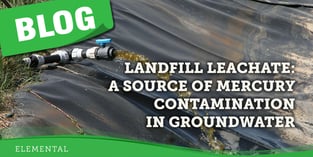What is a Municipal Solid Waste Landfill?
Have you ever wondered what happens to a bag of garbage once it has been collected on trash day? If it is collected from a household or commercial site, it will likely end up at the Municipal Solid Waste Landfill (MSWLF). These are highly engineered facilities that are designed, operated, and continuously monitored to ensure the protection of human health, the environment, and water sources from solid wastes and the chemicals that they are composed of. These areas are made with special liners, leachate management systems, ground water monitoring systems, and eventually specialized cap systems to prevent erosion and infiltration.
How does a solid waste landfill generate liquid waste?
When trash ends up in the landfill, rain falls on the pile creating a liquid waste stream. This process is just like making a pot of coffee. While the end products are very similar in color, their aromas are quite different! As rainwater percolates through the waste pile, the water interacts with everything in the pile as it trickles down through the garbage. As it flows to the bottom, the rainwater collects potentially harmful things like heavy metal ions, PFAS, and dissolved organic matter. Instead of getting an enjoyable cup of coffee, you get a contaminated soup called leachate. It is important to test leachate for chemicals like heavy metals and volatile organics because they are known to be toxic to humans and the environment. It is also important to test the groundwater around the landfill to ensure the leachate isn’t escaping into the environment.
How is this liquid waste regulated?
The federal government sets minimum regulations (Title 40 of the Code of Federal Regulations (CFR) part 258) for various aspects regarding MSWLFs including but not limited to:
- Location and Design
- Leachate collection, removal, and treatment
- Groundwater monitoring
This federal code also lists 62 “Constituents for Detection Monitoring” in Appendix I. Groundwater must be screened for contaminates on this list semi-annually and any statistically significant increases over the established baseline for that contaminate must be reported. If a contaminate from Appendix I is reported, then all 214 constituents listed in Appendix II must be determined. Total Mercury is listed in Appendix II.
Why is it necessary to assess waste streams for mercury?
Mercury is a bio-accumulative, toxic element that can be found in water. It occurs naturally and can also be released to the atmosphere, soil, and water from a variety of anthropogenic sources, like landfill leaks. Groundwater analysis is a crucial part of environmental monitoring. Groundwater is an essential source of drinking water and therefore its safety is critical. Contamination occurs when chemicals are introduced to the underground systems from a variety of sources including industrial discharges, agriculture, urban activities, spills, and leaks.
How can we check for mercury contamination and what is the maximum contamination limit?
The Ground Water Protection Standard (GWPS) is based either on the maximum contaminate level (MCL) found in the Safe Drinking Water Act (SWDA) or the background level of the chemical at that site. The MCL for mercury in groundwater is 0.002 mg/L, or 2 parts per billion.
Teledyne LABS offers multiple mercury (Hg) analyzers which can determine total mercury concentrations in groundwater samples. Each regulatory method will specify the analytical technique that is acceptable. The most common techniques for mercury analysis in aqueous samples are cold vapor atomic absorption (CVAA) and cold vapor atomic fluorescence (CVAF). CVAF is often paired with gold trap amalgamation to increase the sensitivity. The QuickTrace line of mercury analyzers consists of the QuickTrace M-7600 (CVAA) and the QuickTrace M-8000 (CVAF). Determining which analyzer would be best for your aqueous samples will depend on your unique analytical circumstances.
Teledyne LABS mercury analyzers are a cornerstone of environmental laboratories around the globe. Visit the links below to read groundwater Application notes for methods such as USEPA 245.7, ISO 12846, and ISO 17852.
- AN1506 M8000 Groundwater EPA 245.7 VS ISO 17852
- AP-M7600-004 ERM-CA615 EPA 245-7 Application Note
- AP-M7600-005 ERM CA615 ISO 12846 090913 Application Note
References:
https://www.epa.gov/landfills/municipal-solid-waste-landfills
https://www.epa.gov/landfills/requirements-municipal-solid-waste-landfills-mswlfs#groundwater
https://www.ecfr.gov/current/title-40/chapter-I/subchapter-I/part-258?toc=1
https://www.ecfr.gov/current/title-40/chapter-I/subchapter-I/part-258/subpart-E
For more information on mercury analyzers offered by Teledyne LABS, visit our new website: https://www.teledynelabs.com/products/elemental/mercury-analyzers or if you would like someone to contact you - click the button below.

